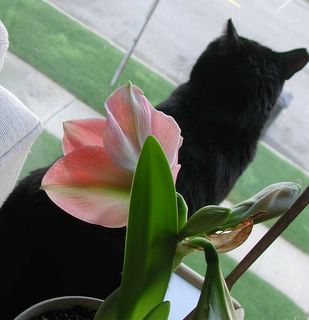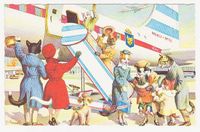
Martin Scorsese © 1991 David Ehrenstein
. . .Martin Scorsese and me, that is. I've been going to the movies since 1947. The first film I remember is The Egg and I. I liked it then and still do. But of all the movies I've seen, The Aviator strikes me as not just Best Picture of the Year, but among the Best. . .Ever!
Unusual for me, because I tend to loathe film biography. Just like Josef Goebels when he heard the word "culture," at the sound of the word "biopic" I tend to reach for my gun. Protagonist is born, triumphs, falls from grace, rises from the ashes like a phoenix , The End. Textbook example of which is Ray, which I'll confess I've not seen and simply won't. I love Ray Charles too much.
Everything I've read and seen about Ray suggests paint-by-numbers biopic, and I can still recall Jamie Foxx "doing" Ray Charles back on the old In Living Color TV series. I didn't find it terribly amusing then, and don't think I would now. Or, "moving," or "riveting," or "engrossing," or however else it is I'm supposed to feel about Foxx's performance. No matter how much one might have liked the film, it's inarguable that it doesn't advance the art of film much, if at all. Nor does Million Dollar Baby, I think I can safely say without having seen it either. Why, in the name of gawd, would anyone want to go to a movie about women beating the crap out of one another? (Now, mud wrestling. . .that's another matter.) The name of Hillary Swank's character alone---Maggie Fitzgerald (give me a break)---is enough to clue you in that you're really in for thirties-retrograde-Warners-melodrama country with this one. If I want that, I'll just re-watch Three on a Match (1932), starring the late, great Ann Dvorak. . .thank you very much.
Besides, Hillary Swank has the big scary teeth, and if that's an Appalachian accent (?) she's supposed to be doing in the film, I think dialect wiz Robert Eastman would give her an "F" and send her packing.
I loved every minute, every frame of The Aviator. How much hipper can you get than the fact that the early part of the film is shot in antique two-strip technicolor and the latter half (later on in time) three-strip? Not sure if the the two-strip is faked or whether it's the real thing, but that just knocked me out (my car used to bear a "Bring Back Two-Strip" bumber sticker).
The Aviator really isn't a biopic per se, but rather Scorsese and company's "take" on what might be Howard Hughes subjective sense of who he thought he was. A very literary conceit adapted to the big screen. For example: the way Hughes' phobia of blacks is only very quietly invoked at the beginning of The Aviator, and then worked throughout the fabric of the film in subtle ways, without hammering one over the head with it. Topped off by the playing of the sound of African-American blues legend Leadbelly singing "The Ballad of Howard Hughes and Katharine Hepburn" (or whatever it was called) over the end credits! When Scorsese happened upon the existence of the Leadbelly track, you could probably have heard him plotzing the length of the 57th Street NYC canyon where his office and editing facilities are are located.
I also appreciated the fact that here CGI was used for something worthwhile, instead of, per ususal, only employed to convey the sense of a monster from the netherworld ripping the guts open of a woman with child (or some such sequence). AND THAT before the credits have even begun.
The Aviator is chock-a-block with computer imagery, but it's all used to tell and advance the story, anddddd, most of all, from the perspective of its backers, to save production money. When DeCaprio as Hughes crashed that plane in Beverly Hills, I was pinned against my seat back for every second of the FX-laden scene. At its conclusion, I almost felt like jumping to my feet and applauding just the way one might for a bravura operatic turn. It's sad to see such a forward-thinking film as the The Aviator get swept aside the way it did Oscar night. Not since Chariots of Eggs won best pic award back in '81 has a film any more conservative in conception and execution as Million Dollar Baby been accorded that honor. Perhaps that tells us something about the uptight, happy-times-are-gone-again days we live in. At least I'm glad the physically-challenged have turned on the film in protest of the assisted suicide of Swank's character at the conclusion of MDB.
And if, as Swank has kept insisting these past few months, she is just a little white trash girl from a trailer park with a dream, I would say that the dress she wore to pick up her award certainly was proof of at least the "trailer park" part. What in the name of Edith Head was she wearing? It caused Swank to resemble---even though she is in fact slim as a reed---one of those Helen Hokinson dowager-type ladies, circa the New Yorker, circa '20s-40s. Or as Cintra Wilson would have it Monday morning in her post-Oscar wrap-up in Salon Magazine, "an erotic balloon-animal made of inner tubes."
As for the new more efficient, "soup line" method of handing out certain, ummm, lesser technical awards. . .in the immortal words of Singin' in the Rain vamp, Olga Mara: "I think it's vulgar."



















